Insufficient Indoor Lighting
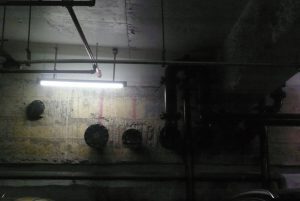
Example of insufficient lighting at basement area
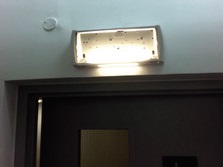
Damaged exit sign; may interfere with egress during evacuation
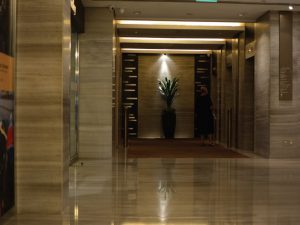
Example of an acceptably lighted hotel lift lobby
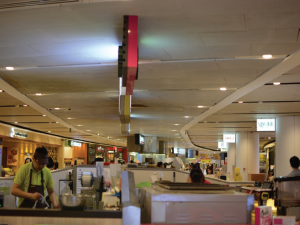
Example of an acceptably lighted common area
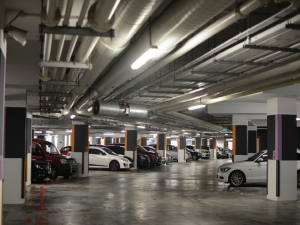
Example of an acceptably lighted basement carpark
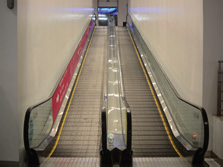
Example of non-visible step demarcation light on escalator
Design Guidelines
- Factors affecting luminous environment (i.e. luminance distribution, illuminance, glare, directionality of light, colour aspect of the light and surfaces, flicker, daylight, maintenance) must be considered. Comply with the design values provided in SS 531-1:2006 (2013) Clause 5. (See also ISO 8995-1:2002).
- Ensure that the lighting in indoor spaces are efficient, comfortable, and safe for visual tasks in the work period; ensuring visual comfort, visual performance, and visual safety (SS 531-1: 2006(2013)). (See also ISO 8995-1:2002).
- For stairs, escalators, and travellators: maximum lighting power density is 6 W/ m2 as per SS 530:2014. (See also ANSI/ ASHRAE/IES Standard 90.1:2013).
- Ensure that common area receives >150% of designed illuminance on a typical rainy day. An automatic daylight control, either determined by a photosensor or schedule, is mandatory (SS 530:2014). (See also ANSI/ASHRAE/IES Standard 90.1:2013).
Construction Guidelines
- The lighting installation should meet the lighting requirements of a particular interior, task or activity without wasting energy. Recommended task lighting levels are provided as maintained illuminance (i.e. depends on maintenance characteristic of the lamp, the luminaire, the environment and maintenance programme).
- A sufficient level of lighting is required to maintain safety (ISO/ TR 22411:2011).
- To reduce and eliminate stairway accidents, the switches that control the stair lights should be placed at a sufficient distance from the stairs — far enough to eliminate the risk of a person falling while reaching for the switch. Three-way switches should be installed at the top and bottom of the stairs [1].
- Provide ceiling lights to orient people along walkways and use contrasting colour luminance at base boards, walls and doors to delineate access routes. especially for people with limited vision and people with autism or cognitive disabilities [2].
Maintenance Guidelines
- The essential documents to be handed over to Maintenance are [3]:
1. As-built lighting layout
2. Lighting schedule
3. Lighting data sheets. - Lighting zoning in accordance to operational requirements. Use energy-efficient lighting such as LED. All LED lightings must be visibly flicker-free when dimmed. Lux level and uniformity to comply with SS 531- 1:2006(2013). (See also ISO 8995-1:2002).
- Where daylighting is available, lighting control strategies can be employed to reduce energy consumption while maintaining the desired illuminance level. Provide sensor to dim lights by 50% when no one is using the staircase (within compliance to local Fire Codes) (ANSI/ ASHRAE/IES Standard 90.1-2016).
- Preparation of comprehensive maintenance schedule to include lamp replacement, luminaire cleaning intervals and cleaning method (SS 531-2:2008(2014)). (See also CIE S 015/E:2005).
References
[1] Watson, E. and Crosbie, M. J. (2004). Time Saver Standards for Architectural Design: Technical Data for Professional Practice (8th ed.). USA: McGraw-Hill Professional.
[2] Canadian Human Rights Commission (2007). International Best Practices in Universal Design: A Global Review (Rev. ed.). Canada: Canadian Human Rights Commission.
[3] Building and Construction Authority (2016). Green Mark for Non Residential Buildings NRB: 2015. Singapore: BCA.
Normative References/Standards Referred to for Indoor Lighting
• ANSI/ASHRAE/IES Standard 90.1:2013 — Energy standard for buildings except low-rise residential buildings
• CIE S 015/E:2005 — Lighting of Outdoor Workplaces
• ISO 8995-1:2002 — Lighting of work places — Part 1: Indoor
• ISO/TR 22411:2011 — Ergonomics data and guidelines for the application of ISO/IEC Guide 71 to products and services to address the needs of older persons and persons with disabilities
• SS 530:2014 — Code of practice for energy efficiency standard for building services and equipment
• SS 531-1:2006(2013) — Code of practice for lighting of work places — Indoor
• SS 531-2:2008(2014) — Code of practice for lighting of work places — Outdoor